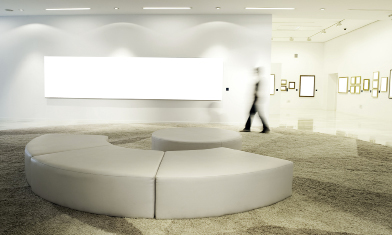Module 1 Conclusion
Module 1 Conclusion
Module 1 Conclusion

© Luna Vandoorne/shutterstock
As you look closely at your home and your community, you will see many objects of interesting shape and size. In some instances, an object’s form is designed to be visually inspiring. For example, the design of buildings in modern architecture often emphasizes creativity and beauty.
On the other hand, even in architecture, the buildings need to be designed to fulfill their functions. A library will be designed in a different way than a hardware store. Likewise, a bank will incorporate security into its design while a shopping mall will emphasize accessibility.
On a smaller scale, a drinking glass is designed in the shape of a cylinder for many practical reasons. One reason is that a cylindrical glass is easier to hold. Such a glass is also easily stored with other glasses of the same shape.
Similarly, a bookcase has rectangular openings so that more books can be stored and retrieved than if they were placed on a bookcase with circular openings.
In this unit you examined the 3-D objects around you. You began by reviewing the SI and imperial measurement systems. You used referents to obtain approximate measurements of various objects. You also learned how to convert measurements between the SI and imperial systems.
In this unit you built upon your knowledge of volume and surface area by extending those concepts to cylinders, cones, pyramids, and spheres. You investigated these properties by conducting math labs and using interactive multimedia.
Later, you calculated the volume and surface area of the 3-D objects found in your special place that you described in the Unit 1 Project.
At the end of this unit, you learned about trigonometry and how its concepts are used to determine measurements that are not easily obtained directly. For example, you learned to use a clinometer to determine the angle of elevation to the top of a tall structure. You then used the tangent ratio to find the height of the structure without actually measuring it.
At the end of the unit, you had the opportunity to apply trigonometry concepts to word problems. You learned that sketching the scenario and choosing the right ratio were important steps in finding the solutions to these problems.
The following table summarizes the learning outcomes and corresponding learning activities in this unit.
|
Specific Outcome |
Major Learning Activities That Address Specific Outcome |
|
Solve problems that involve linear measurement using
|
Lesson 1
Lesson 2
|
|
Apply proportional reasoning to problems that involve conversions between SI and imperial units of measure. |
Lesson 3
|
|
Solve problems, using SI and imperial units, that involve the surface area and volume of 3-D objects, including:
|
Lesson 4
Lesson 5
Lesson 6
|
|
Develop and apply the primary trigonometric ratios (sine, cosine, tangent) to solve problems that involve right triangles. |
Lesson 7
Lesson 8
|